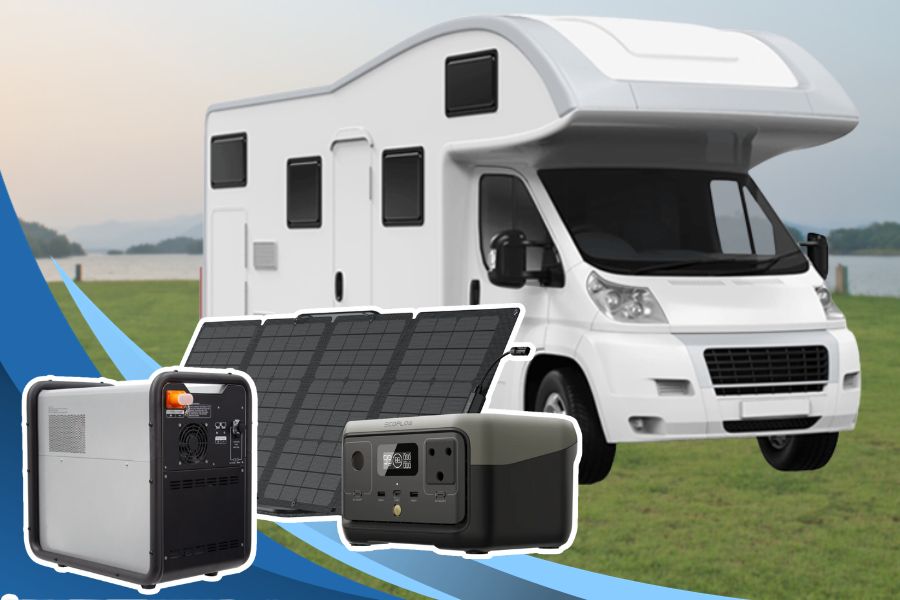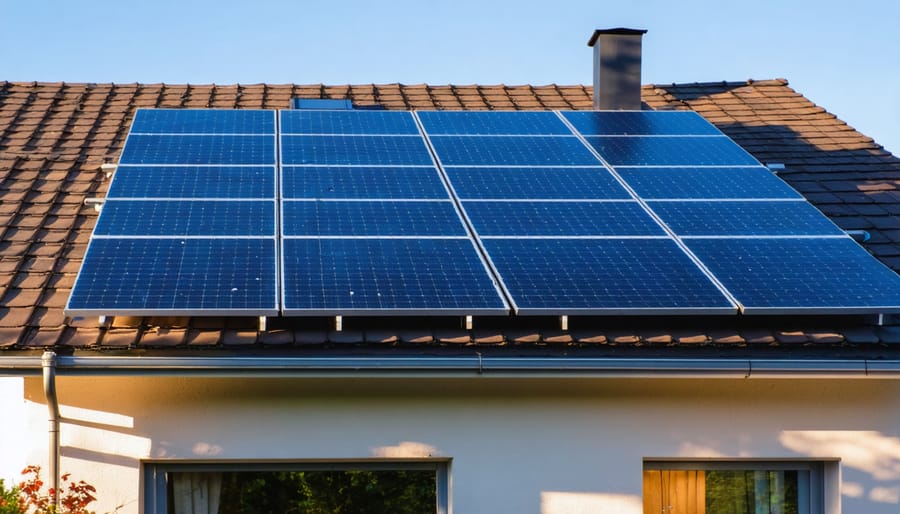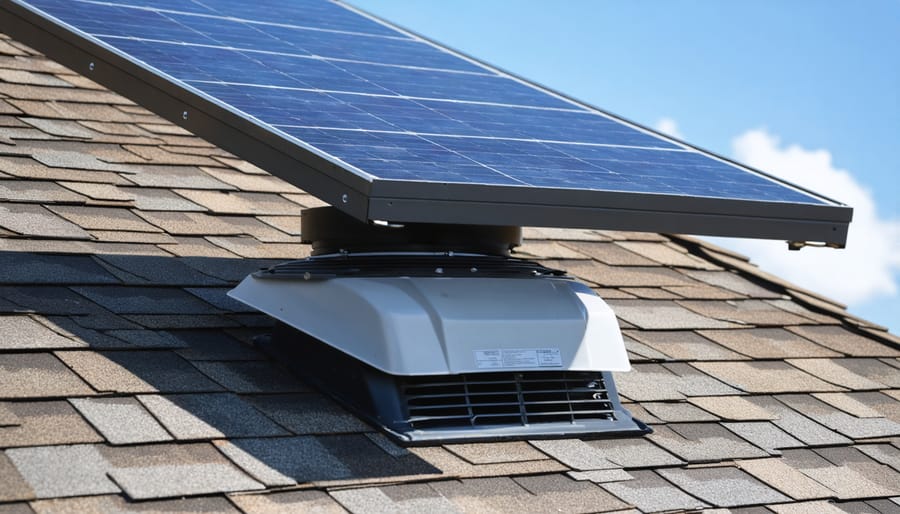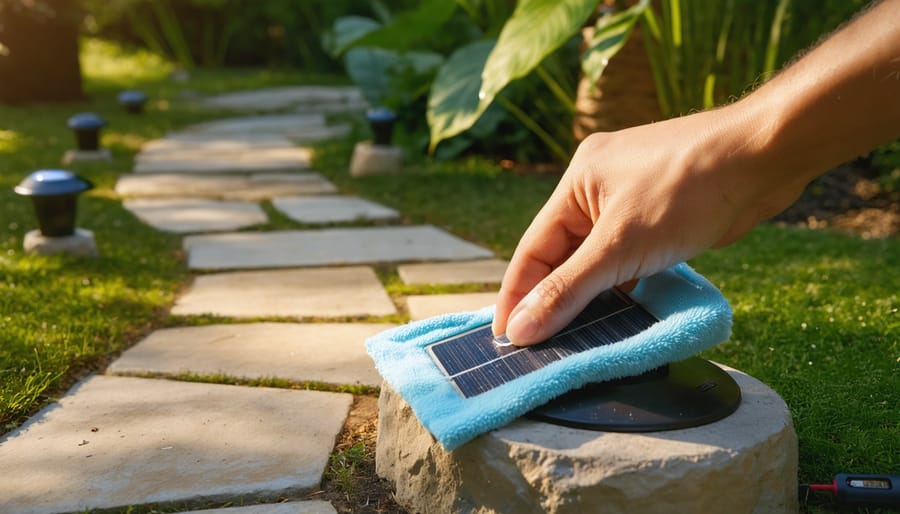Your Camping Trip Needs Silent Power (Here’s How to Get It)
Updated:

Choose a portable power station with an inverter rating below 50 decibels—quieter than normal conversation—so you can run your essential camping gear without the rattling drone that ruins peaceful mornings at the campsite. Unlike gas generators that shatter the tranquility you came outdoors to find, modern lithium battery power stations operate in near silence, giving you the electricity you need while preserving the sounds of nature around you.
I’ll never forget my first camping trip after switching from a traditional generator to a quiet power station. Instead of waking to that mechanical roar at dawn, I heard birds singing and leaves rustling—exactly what I’d driven three hours to experience. That moment convinced me that getting electricity while camping doesn’t mean sacrificing the peace you’re seeking.
The technology behind these quiet devices is surprisingly straightforward. They store energy in lithium batteries and convert it to usable AC power through inverters that contain no moving parts. No engine combustion, no spinning mechanical components—just smooth, silent electricity flowing to your devices. This makes them perfect for powering everything from CPAP machines and mini-fridges to phones and laptops without disturbing your tent neighbors or wildlife.
Sizing your power station correctly matters more than you might think. A weekend camper running LED lights and charging phones needs around 300-500 watt-hours, while someone powering a portable fridge for extended trips should look at 1000+ watt-hours. Pairing your station with portable solar panels transforms it into a completely renewable system, letting you recharge during the day and enjoy endless quiet power under the stars.
Why Noise Matters More Than You Think at the Campsite
I’ll never forget the weekend my old generator got me kicked out of a campsite. Well, not literally kicked out, but the ranger’s pointed conversation about “respecting quiet hours” made it clear I wasn’t winning any neighbor-of-the-year awards. That whirring, coughing beast measured around 65-70 decibels—about as loud as a vacuum cleaner running next to your tent. Not exactly the peaceful nature escape I’d promised my family.
Here’s what most campers don’t realize: noise pollution doesn’t just annoy people—it fundamentally disrupts the entire outdoor experience. Wildlife relies on natural soundscapes for communication, hunting, and predator awareness. When generators drown out these cues, animals either flee or become stressed. Fellow campers who’ve driven hours to hear birdsong and rustling leaves instead get an industrial soundtrack. It’s the opposite of what we’re all seeking in nature.
Traditional generators typically rumble between 60-85 decibels depending on load and model. In contrast, modern quiet portable power stations operate at 25-45 decibels during normal use—quieter than your refrigerator at home. Many models are virtually silent because they have no moving parts or combustion engines. This dramatic difference has made many campgrounds rethink their policies on solar panels versus generators.
The shift toward quieter camping isn’t just about following rules—it’s about preserving what makes outdoor experiences special. More campgrounds now specifically restrict gas generators during certain hours or ban them entirely, while welcoming silent power stations. These regulations reflect what campers increasingly want: the ability to power modern conveniences without sacrificing the tranquility that drew them outdoors in the first place.
When you can charge devices, run a portable fridge, or power LED lights without disturbing a single cricket’s chorus, you’re experiencing camping as it should be—connected to both nature and your essential comforts, without compromise.

What Makes a Portable Power Station ‘Quiet’?
The Silent Components That Make It Possible
The magic of a quiet portable power station comes down to three essential components working in harmony. Let me break down what’s happening inside that sleek box—I promise it’s less complicated than it sounds!
**Lithium batteries** are the heart of the system. Unlike the lead-acid batteries in traditional generators, lithium batteries don’t need combustion or moving parts to create power. They store energy chemically and release it silently when you need it. I remember my first camping trip with a lithium power station—the contrast with my old gas generator was night and day. No rumbling engine, just clean, stored energy ready to go.
**Inverters** are the translators of your power station. They convert the DC power stored in batteries into the AC power your devices need. Modern inverters use advanced electronics instead of mechanical switches, which means they operate almost silently. You might hear a faint hum when powering large appliances, but it’s barely noticeable—certainly nothing like a generator’s roar.
**Cooling fans** are the only moving parts in most quiet power stations, and manufacturers have gotten clever here. Many units use temperature-controlled fans that only spin when needed, and when they do activate, they’re whisper-quiet. Some premium models even use passive cooling systems with heat sinks, eliminating fans entirely for truly silent operation during light loads.
Together, these components create a power solution that respects the peace of nature while keeping your gear running.

Decibel Levels: What You Actually Hear
When shopping for a quiet portable power station, you’ll see noise levels measured in decibels (dB). But what does that actually mean for your camping experience?
Let me put this in perspective with sounds you know. A whisper-quiet library measures around 30 dB—that’s the gold standard for portable power stations designed for peaceful outdoor settings. Most quality units operate between 30-40 dB, which is quieter than a typical refrigerator hum (around 40 dB) and significantly softer than normal conversation at 60 dB.
I learned this firsthand during a camping trip when my buddy’s traditional generator roared at 65 dB—loud enough that we couldn’t hear each other talk without raising our voices. Meanwhile, my portable power station hummed along at 35 dB, barely audible over the gentle rustling of leaves.
Here’s a practical rule: anything under 40 dB won’t disturb your campsite neighbors or wildlife. Between 40-50 dB, you’ll notice it but won’t find it bothersome. Above 50 dB? That defeats the purpose of choosing a “quiet” power solution.
Most modern portable power stations only produce fan noise when cooling is needed, meaning they’re often completely silent during light loads—perfect for those peaceful mornings sipping coffee while the sunrise charges your solar panels.
Matching Your Power Needs to the Right Station
Weekend Camping Essentials
For a typical weekend camping trip, you’ll want a portable power station in the 200-500Wh range—think of this as having enough juice to keep your essentials running without lugging around something the size of a car battery.
Let me share what I’ve learned from countless camping trips: Your phone charger needs about 10-20 watts, while a small LED camping lantern uses roughly 5-15 watts. A portable fan draws around 15-30 watts, and those compact coolers that keep your food fresh typically require 40-60 watts. On a recent trip to Joshua Tree, my 300Wh unit comfortably powered two phones, our LED string lights, and a small fan for two full nights without breaking a sweat.
Here’s a simple way to calculate your needs: Add up the watts of everything you’ll run simultaneously, then multiply by the hours you’ll use them. A 300Wh station can power a 30-watt device for about 10 hours, accounting for some efficiency loss.
The beauty of these quiet units is they work harmoniously with solar panels during the day, recharging while you explore. You’re essentially creating a whisper-quiet, renewable power loop that respects both the wilderness and your fellow campers—no rumbling generators to disturb that peaceful morning coffee moment.
Extended Trips and Comfort Camping
When you’re planning extended camping trips or want genuine comfort in the backcountry, stepping up to a 500-1000Wh+ power station changes everything. I learned this during a week-long camping trip when my modest 300Wh unit couldn’t keep up with our family’s needs—we needed something with real staying power.
At this capacity level, you can comfortably run electric coolers (understanding the power requirements for coolers helps with planning), CPAP machines throughout the night, charge multiple laptops for remote work sessions, and even brew morning coffee with a portable coffee maker. These aren’t luxuries—they’re essentials that make extended outdoor stays possible for many families.
For reference, a typical CPAP machine uses about 30-60 watts and needs to run 6-8 hours nightly, consuming roughly 240-480Wh. Add a 45-watt electric cooler running intermittently and daily device charging, and you’ll quickly see why 500Wh is the starting point for comfort camping.
I recommend 1000Wh models for trips longer than three days or when supporting multiple high-draw devices. Pair these stations with solar panels (100-200 watts), and you’ve created a self-sustaining power ecosystem that keeps running indefinitely—perfect for those who want to extend their outdoor adventures without sacrificing modern conveniences.
Using the Quick Power Calculator
Figuring out exactly what size power station you need doesn’t have to be guesswork. When I first started helping campers choose the right setup, I noticed everyone struggled with the same question: “How much power do I actually need?”
That’s why we created the Spheral Solar Quick Power Calculator—it takes the mystery out of sizing your system. Here’s how to use it:
First, list all the devices you’ll power while camping (phone, laptop, mini-fridge, lights). Next, enter how many hours you’ll run each device daily. The calculator automatically adds up your total watt-hours needed. Finally, it recommends a power station capacity with a built-in safety margin, so you won’t run out mid-trip.
The tool also suggests compatible solar panels if you want to recharge off-grid—perfect for extended camping adventures where noise-free, sustainable power matters most.
Key Features That Separate Good from Great
Solar Charging Compatibility
Pairing your quiet power station with solar panels is honestly a game-changer—I learned this the hard way during a week-long camping trip when I ran out of juice on day three. Now I never leave without my solar setup, and it’s extended my off-grid adventures indefinitely.
The beauty of solar charging is that as long as the sun’s out, you’re generating power. Most modern power stations accept solar input between 100-200 watts, which means a couple of quality portable solar panels can fully recharge a mid-sized unit (around 500Wh) in 4-6 hours of good sunlight. I typically aim for panels that match about 20-30% of my power station’s capacity for optimal charging speed.
Here’s what I’ve learned about placement: angle matters more than you’d think. During summer camping trips, I prop my panels at about 30-45 degrees facing south (in the Northern Hemisphere), adjusting throughout the day if I’m around camp. Even on partly cloudy days, I’m usually pulling 60-70% of the rated power—enough to keep my station topped up between uses.
Pro tip: bring MC4 extension cables so you can keep your power station in the shade while panels bask in full sun. Heat reduces battery efficiency, and you’ll get better performance keeping the unit cool. I also pack a small brush to clear dust or pollen off the panels—you’d be surprised how much a clean surface improves output. With this setup, you’re basically creating your own renewable power source wherever you pitch your tent.
Multiple Charging Options and Port Variety
When choosing a quiet portable power station for camping, port variety can make or break your outdoor experience. I learned this the hard way during a weekend trip when I could only charge one device at a time—not ideal when your phone, camera, and laptop all need juice!
Modern power stations typically offer multiple AC outlets (110V) for larger appliances like mini-fridges or electric coolers, alongside USB-A ports for standard smartphone charging and newer USB-C ports that deliver faster power to laptops and tablets. Don’t overlook DC ports either—they’re perfect for running 12V camping fans or portable air compressors.
Here’s a real-world scenario: imagine you’re at the campsite with your family. Dad needs the AC outlet for his CPAP machine overnight, the kids want to charge their tablets via USB-A, you’re topping up your camera batteries through USB-C, and someone’s running a portable LED lantern from the DC port. With diverse charging options, everyone’s powered up simultaneously without playing musical chairs with adapters.
Look for stations offering at least two AC outlets, multiple USB ports (both A and C types), and at least one 12V DC output. This flexibility ensures you’re prepared for whatever gadgets your camping adventure requires.
Weight, Portability, and Durability
Finding the sweet spot between power and portability really depends on your adventure style. For backpacking trips, I’ve learned the hard way that anything over 10-15 pounds becomes a burden after mile three—look for compact units under 500Wh with sturdy carry handles. Car camping? You’ve got more flexibility to bring 20-30 pound stations with 1000Wh+ capacity.
Build quality matters more than marketing claims. I always check for reinforced corners, quality handle construction (preferably recessed or foldable), and rubberized feet that prevent sliding. Weather resistance is crucial—while most aren’t fully waterproof, seek IP ratings of at least IP54 for dust and splash protection. Remember, a durable power station is an investment that’ll serve you through countless camping seasons, so don’t skimp on construction quality just to save a few dollars.
Real-World Camping Scenarios and Solutions
The Solo Backpacker’s Setup
When I’m hiking solo through the backcountry, every ounce in my pack matters. That’s why I’ve learned to love compact power stations in the 150-300Wh range—they’re light enough to carry but powerful enough to handle essentials like phone charging, GPS devices, and camera batteries.
For weekend trips, a 200Wh unit typically weighs around 5 pounds and fits in most backpacks. I can charge it fully before heading out and still have juice left after keeping my phone and headlamp powered for three days. The silent operation means no disturbing wildlife or fellow campers during those peaceful morning hours.
Consider pairing your power station with a foldable 50-60W solar panel. While it adds a bit of weight, the ability to recharge during sunny rest stops transforms a weekend power supply into a week-long solution. I’ve extended several trips this way, knowing I had backup power without carrying extra battery banks.
For true minimalists, some units now feature pass-through charging, letting you charge devices while the power station itself recharges via solar—maximizing efficiency when every watt counts.

Family Car Camping Comfort
Last summer, my family and I spent four days at a state park, and our 500Wh portable power station became the campsite’s unofficial command center. For a family of four on a long weekend, you’ll want to think about your collective power draw. We ran LED string lights around our tent area (about 10W), charged four smartphones and two tablets daily, powered a small fan for those humid nights, and even kept a portable cooler running intermittently.
Here’s what worked for us: A 500-1000Wh capacity handled everything comfortably. We paired ours with a 100W solar panel, which added about 300-400Wh per sunny day—enough to stay topped up without rationing. The quiet operation meant we could run devices overnight without disturbing anyone, including ourselves.
Pro tip from experience: Calculate your daily usage first. Add up everything you’ll realistically use—phones (20Wh each), lighting, maybe a small electric griddle for breakfast. Then choose a station with 20-30% extra capacity as a buffer. Your family will appreciate having reliable power for those creature comforts that make camping enjoyable rather than endurance training.
The Remote Work Camper
I’ve watched the remote work revolution transform camping, and honestly, it’s pretty exciting. Last summer, I met a software developer named Sarah at a state park who was running her entire mobile office from her camper – laptop, dual monitors, hotspot, phone charger, even a small printer – all powered by a 500Wh portable power station she’d paired with a foldable solar panel.
Here’s what makes these units perfect for digital nomads: they deliver consistent, clean power that won’t damage sensitive electronics. A typical setup with a laptop (50W), hotspot (10W), and phone charging (20W) draws around 80 watts. That means a 500Wh station can power your workday for 5-6 hours straight.
The real game-changer? Pairing your power station with solar panels. I recommend at least 100W of solar capacity to recharge while you’re working. This way, you’re not just camping – you’re running a sustainable, truly mobile office. Look for models with multiple USB ports and at least two AC outlets to handle all your devices simultaneously without adapters cluttering your workspace.
Making Your Power Station Last (Maintenance and Care)
I learned this lesson the hard way when I left my first power station sitting in the garage for months without checking on it. When I finally needed it for a camping trip, the battery was so deeply discharged it took days to recover. Don’t make my mistake—these units need a little love to keep performing at their best.
**Keep That Battery Happy**
The heart of your quiet power station is its lithium battery, and it thrives on regular use. If you’re storing your unit between trips, charge it to about 50-60% capacity. I mark my calendar to check mine every three months, giving it a quick top-up if needed. This sweet spot prevents the deep discharge that can permanently reduce battery capacity while avoiding the stress of keeping it at 100% for extended periods.
Store your power station in a cool, dry place—ideally between 50-77°F. I keep mine in my basement workshop rather than the garage where summer temperatures can soar. Extreme heat is the enemy of lithium batteries and will shorten their lifespan faster than anything else.
**Smart Charging Habits**
While it’s tempting to juice up your power station as fast as possible, slower charging is actually gentler on the battery. When I’m not in a rush, I use solar panels instead of wall outlets—it’s not just environmentally friendly, it’s also the kindest way to charge. If you’re using AC power, avoid leaving the unit plugged in continuously after it reaches 100%.
**Keep It Clean and Ready**
Dust and debris can block cooling vents, causing your unit to run hotter than necessary. I wipe mine down with a dry cloth after each trip and use compressed air to clear the vents every few months. Check all ports for corrosion, especially if you’ve been camping in humid conditions.
Firmware updates might seem like a hassle, but manufacturers often release them to improve battery management. I check for updates quarterly—it takes five minutes and can genuinely extend your unit’s lifespan.
The Solar Advantage: Pairing Panels with Your Power Station
Choosing the Right Panel Size
Here’s a simple rule I’ve learned from years of pairing solar generators for camping with panels: aim for solar panels that can recharge your power station’s battery in 4-6 hours of decent sunlight.
The basic formula is straightforward—take your power station’s battery capacity (in watt-hours) and divide by 5. That gives you the minimum panel wattage you’ll need.
For example, if you’ve got a 500Wh power station, you’d want at least a 100W solar panel. I actually run a 600Wh unit with a 120W panel, and it works beautifully for weekend trips. The panel fully recharges my station by mid-afternoon, giving me plenty of power for evening devices.
For longer camping adventures, consider your daily power consumption too. If you’re using 300Wh per day, a 100W panel can replace that energy in about 3-4 hours of good sun. This means even on partly cloudy days, you’ll stay topped up.
Weekend warriors can get by with smaller panels (60-100W), while week-long campers should look at 100-200W panels for consistent power independence.

Charles’s Easy Solar Setup Method
I’ll never forget my first attempt at solar charging during a weekend at Lake Tahoe—I confidently set up my panel facing what I *thought* was south, only to realize hours later I’d barely captured any charge. That rookie mistake taught me everything I now share with fellow campers.
Here’s my foolproof method: First, arrive at your campsite with at least two hours of good sunlight remaining. This gives you time to experiment with panel placement without pressure. Unpack your solar panel and power station, keeping all connections dry and dust-free.
**Step one**: Find true south using your smartphone’s compass app (not just your gut feeling like I did). Position your panel at about a 45-degree angle if you’re camping in summer, steeper in winter. The goal is perpendicular sunlight hitting those cells.
**Step two**: Connect your solar panel to the power station using the provided cable. Most units have an MC4 connector—it clicks when properly secured. I always give it a gentle tug to confirm it’s locked in place.
**Step three**: Check your power station’s display. You should see input wattage appearing within seconds. If not, adjust the panel angle incrementally. I use rocks or my camping chair to prop panels at different angles until I maximize that input number.
**Common mistakes to avoid**: Never leave panels face-down on grass (moisture damage), don’t daisy-chain incompatible panels, and always disconnect during storms. Also, partial shade kills efficiency—even a small shadow from a tree branch can reduce output by 50%.
The evolution of quiet portable power stations has genuinely revolutionized how we experience the outdoors. No longer must we choose between the comforts of modern technology and the tranquility that draws us to nature in the first place. These remarkable devices have eliminated the disruptive drone of traditional generators, allowing us to charge our devices, power our lights, and run essential equipment while preserving the peaceful ambiance that makes camping so restorative.
I’ve witnessed this transformation firsthand during countless camping trips with my family. There’s something profoundly satisfying about sitting around a campfire under starlit skies, knowing that our power station is silently working in the background—ready when we need it, invisible when we don’t. It’s this seamless integration of convenience and wilderness appreciation that represents the best of what modern solar technology can offer.
We’d love to hear about your own experiences with quiet power stations! The Spheral Solar community thrives on shared knowledge and real-world insights. Whether you’ve discovered a clever way to maximize your solar charging setup, found the perfect capacity for your specific needs, or simply want to share your peaceful camping moments, your stories help others make informed decisions and inspire new approaches to outdoor power solutions.
As I reflect on my journey from noisy generator dependency to embracing whisper-quiet solar power, I’m reminded that finding balance in our outdoor experiences doesn’t mean sacrificing one thing for another. It means thoughtfully integrating the tools that enhance our adventures while respecting the natural environments we cherish. That’s the sweet spot where technology and nature coexist harmoniously—and where your next camping adventure begins.










